radiotelescope
Latest
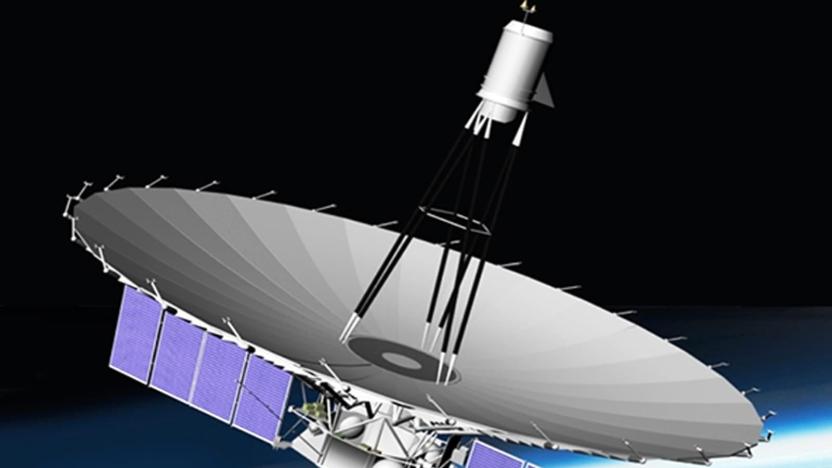
Russia lost control of an orbiting radio telescope (updated)
Russia's astronomy program is facing a significant setback. The country's orbital Spektr-R radio telescope has stopped responding to commands since January 11th. While it's still transmitting signals, the satellite effectively can't be used for future tasks in its current state. The space agency Roscosmos said it would next try to regain control and fix issues on January 13th at 2PM Moscow time (6AM Eastern), but it's not clear what would happen after that.
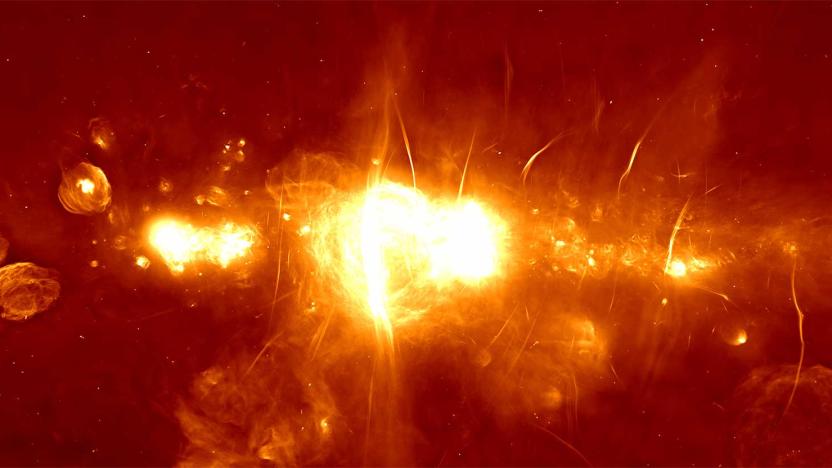
Ultra-sensitive radio telescope debuts in South Africa
Another piece of the Square Kilometer Array's puzzle just fell into place. South Africa has officially switched on MeerKAT, billed as the most sensitive radio telescope of its type on the planet. Some parts of the array have been gathering data, but it's now nearly ready to use interferometry from all 64 dishes to map the normally invisible portions of space in exceptionally high detail. It should be completely ready for scientific experiments in about two months, according to Nature. However, you won't have to wait that long to see fresh results -- you're looking at some above.
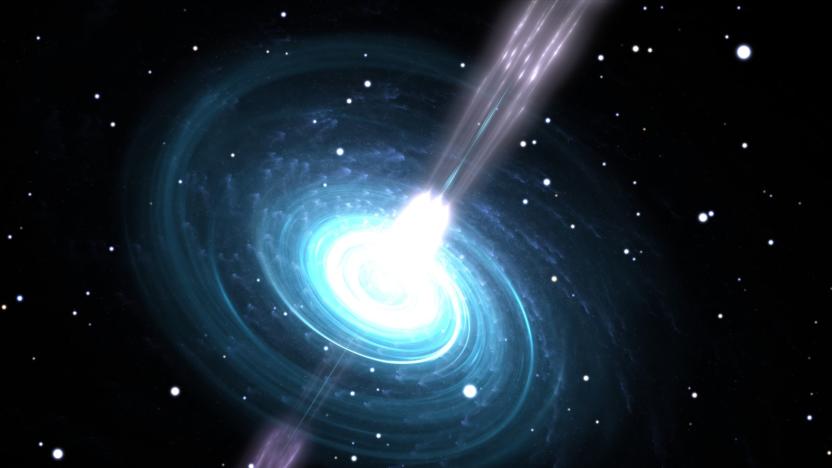
Radio telescopes show theory of gravity holds in extreme situations
Radio telescopes have been crucial to some significant discoveries regarding the nature of the universe. Now, though, they're verifying the basic rules of the cosmos. An international group of astronomers has shown that Einstein's theory of gravity holds up even in more extreme situations. The team spent six years using a trio of radio telescopes (Arecibo, Green Bank and Westerbork Synthesis) to track an unusual three-star system with a pulsar bracketed by two white dwarfs -- a textbook example of extreme gravity in action. How that pulsar moved would determine whether or not Einstein's concept passed muster.
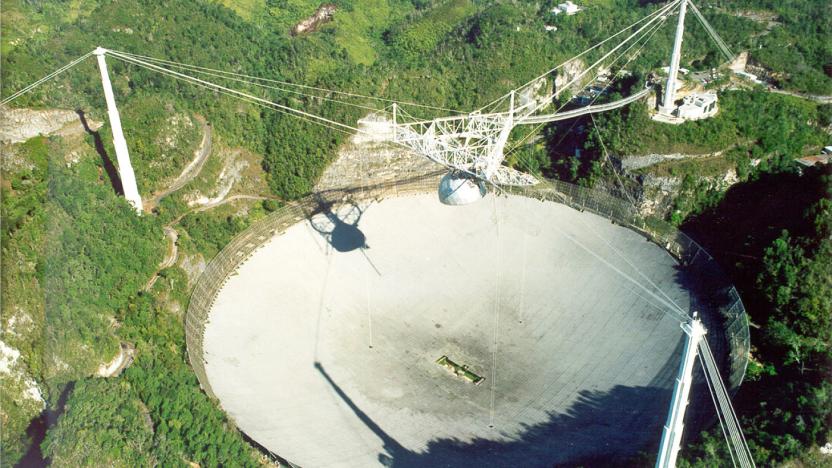
Arecibo is monitoring potentially hazardous near-earth asteroid
The iconic Arecibo radio telescope has faced quite a few challenges over the last ten years, including budget cuts, a funding crisis and damage from Hurricane Maria. While it may not be the largest radio telescope in the world anymore (that honor belongs to Russia's RATAN-600), Puerto Rico's device is still an important asset for detecting dangers to our planet. It's good news, then, that the telescope is up and running again to be able to check out near-Earth asteroid 3200 Phaethon.
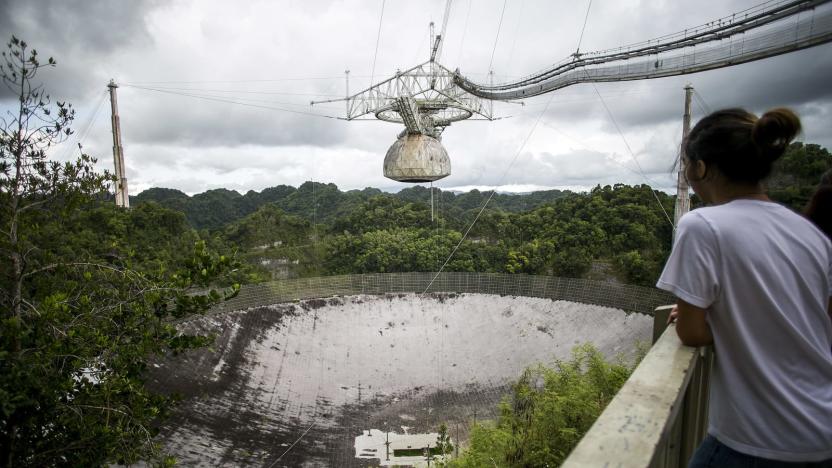
Hurricane Maria wreaks havoc on Arecibo radio telescope
Puerto Rico is suffering on an unimaginable scale in the wake of Hurricane Maria. Many have been displaced from their homes, and the entire territory may go without electricity and reliable communication for months. And while the human tragedy is clearly the most important concern, it's also having a terrible effect on the scientific community. Researchers have learned that the Arecibo Observatory and its signature radio telescope took significant damage when the hurricane passed over. All staff members are thankfully safe for now, but an atmospheric radar line feed and a 39-foot dish (used for Very Long Baseline Interferometry) were lost in winds that reached up to 155MPH. The gigantic central dish is intact, although the line feed's collapse punctured it in places.

Canada's new radio telescope starts mapping the universe
On September 7th, an extraordinarily powerful radio telescope in Canada has begun listening to the sounds of the universe. The Canadian Hydrogen Intensity Mapping Experiment or CHIME will help scientists learn more about the history of the cosmos, radio bursts from pulsars and gravitational waves, the ripples in spacetime whose existence were finally confirmed by scientists in 2016.
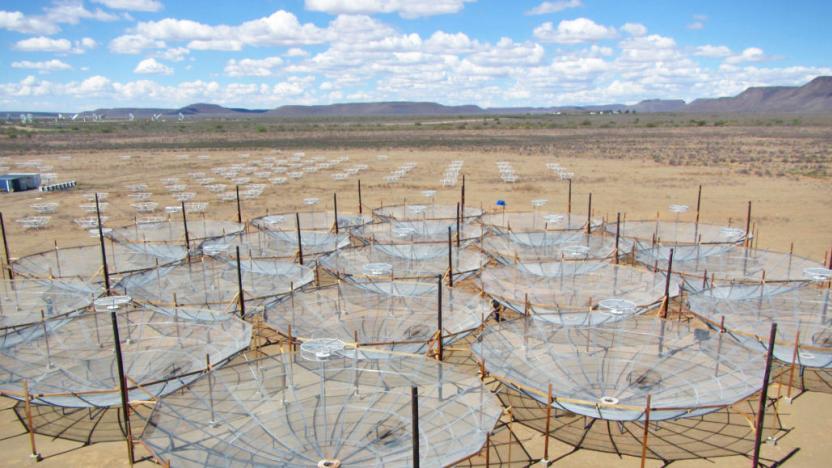
HERA telescope upgrades could reveal the earliest stars
When it first went online in February 2016, the Hydrogen Epoch of Reionization Array (HERA) radio telescope in South Africa boasted 19, 42-foot-diameter antennas aimed at the "Cosmic Dawn" of the universe. The antennas are designed to detect a specific wavelength of light emitted by hydrogen atoms during what's called the "Epoch of Reionization," which scientists believe started about 400 million years after the Big Bang. By picking up these wavelengths of light, HERA will be able to form a clearer picture of the universe at a time when the first stars and galaxies were being formed, more than 13.7 billion years ago.
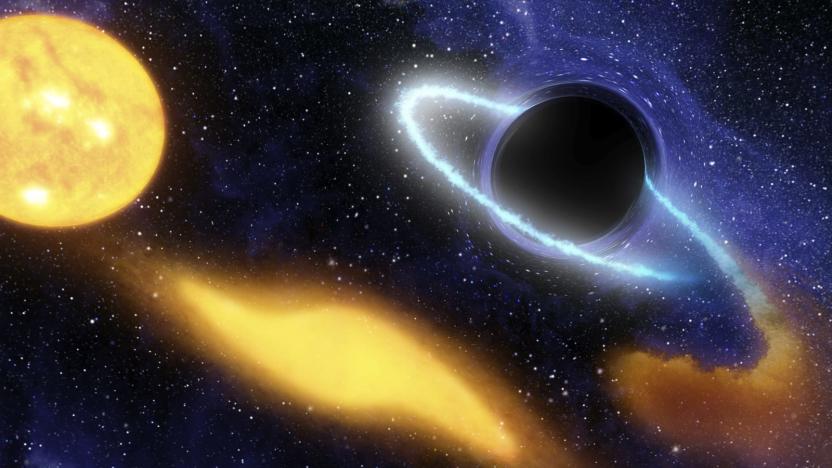
Black hole detection is becoming much easier
It's still relatively difficult to spot black holes (after all, they trap light), but it may be relatively commonplace in the near future. An international team of researchers has developed a detection technique that should identify a more frequent 10 black holes per year. By using radio telescopes to capture multiple snapshots of gravitational microlensing events (where objects like black holes bend light), you can obtain details like distance, mass and velocity for subjects you can't easily study using visible light.

SETI's 'unusual signal' most likely came from Earth
With apologies to the would-be Dr. Ellie Arroways out there: the "unusual signal" picked up by SETI using Russia's RATAN–600 radio telescope and thought to be originating from a star in the Hercules constellation is almost certainly coming from Earth and not some advanced alien civilization. In a statement the Special Astrophysical Observatory of the Russian Academy of Sciences wrote: "Subsequent processing and analysis of the signal revealed its most probable terrestrial origin."

SETI researchers investigate an unusual signal
The hunt for alien life might have turned up something special. A Search for Extraterrestrial Intelligence team using Russia's RATAN-600 radio telecope (above) is investigating an unusually strong signal from a star 95 light years away, in the Hercules constellation. It's far from conclusive evidence of sentient beings. However, it's interesting enough that team members have called for "permanent monitoring" of their target, and have managed to get help from both the Allen Telescope Array in California as well as Panama's Boquete Optical Observatory.

China finished the world's largest single-aperture telescope
For the past 53 years, Puerto Rico's Arecibo Observatory has been the king of radio telescopes. No more. China has just finished construction of its Five hundred meter Aperture Spherical Telescope (FAST), which is 64-percent larger. That makes it the worlds largest single-aperture telescope -- the world's largest radio telescope is Russia's RATAN-600, which has a sparsely filled aperture.

New algorithm may lead to a picture of an actual black hole
MIT grad student Katie Bouman and her team have developed an algorithm that could finally show us a photo of an actual black hole. See, all the black hole "photos" you've seen thus far, including the one above, are merely artist interpretations depicting what we think they look like. In order to capture, say, a picture of the supermassive black hole in the center of our own galaxy, we'll need an enormous telescope with a diameter almost as big as our planet. Since it's impossible to build something that massive, Bouman's algorithm called Continuous High-resolution Image Reconstruction using Patch priors or CHIRP stitches data gathered by the Event Horizon Telescope array.

The Arecibo radio telescope is in trouble again
Unfortunately, the Arecibo Observatory's iconic radio telescope is facing an uncertain future once again... and there's only a short amount of time for you to have a say in its fate. The National Science Foundation is considering a number of options for the space-centric facility, including either putting its operations in the hands of partners or shutting it down entirely. It's holding public meetings today (June 7th) and accepting written comments until June 23rd to discuss the "environmental impact" of its options, but there's a good chance that the conversation will revolve around the telescope's survival.

Galaxy studies show that the universe is slowly dying
Not to bum you out, but many scientists believe that the universe will eventually die -- stars and even black holes will release energy until there's virtually nothing left. And unfortunately, there's now stronger evidence that this inexorable decline is real. Scientists using radio telescopes have measured the energy output of 200,000 galaxies with greater precision than ever, and they've determined that these star havens are only producing half as much energy as they were 2 billion years ago. In short, the universe is fading out. This isn't surprising (entropy is inescapable in our understanding of physics), but it does downplay theories that the universe might maintain or even regain energy.

Murchison Widefield Array goes live, will study the sun, space junk, the early universe and more
We hope IBM's hardware is ready to chew through the feast of data it's going to receive, as the Murchison Widefield Array (MWA) radio telescope is officially open for business science. Located in the outback on the same site as the Australia SKA Pathfinder, it's one of three "precursor" programs that'll help steer future development of the extra powerful Square Kilometer Array. The MWA low-frequency telescope has plenty of work to be getting on with, and some of its first tasks include gazing into the sun to observe solar flares, storms and other activity, as well as scanning the Milky Way for the likes of "black holes and exploding stars." It'll also look into the tracking of hazardous space garbage using FM radio waves that are lost to the void, and explore the early life of the universe as far back as 13 billion years. According to Curtin University's Professor Tingay, the MWA's commendable work ethic (read: data quality) means we could see initial results from some of these projects "in as little as three months' time."

Australia Square Kilometre Array Pathfinder goes live as the world's quickest radio telescope
Australia's Shire of Murchison is quickly becoming a hotbed for radio telescopes. As of of Friday, the territory is operating the world's fastest radio telescope in the form of the Australia Square Kilometre Array Pathfinder (ASKAP). The 36-antenna grid's eventual use of six phased array feeds, each with 188 receivers, will let it scan a field of view 150 times larger than the moon's visible area while processing that information much faster than a typical single-pixel radio telescope feed -- CSIRO estimates that an image of the Centaurus A galaxy that would take 10,000 hours to process with rivals should take five minutes with ASKAP. Ultimately, the array should grow to 60 antennas as part of the Square Kilometer Array, which includes South Africa in its hunt for pulsars, quasars and other unique parts of the universe. Just don't get your hopes up for booking alien listening sessions anytime soon. Commissioning started virtually as soon as the ribbon was cut, and scientists have already scheduled their usage slots for the next five years. We're sure we'll get over any frustration when we see the first ASKAP results published within the next year.

Radio astronomy pioneer Sir Bernard Lovell dies at 98
Astronomy just lost one of its vanguards, as Sir Bernard Lovell has died at 98. The UK-born scientist was best known as a cornerstone of radio telescope development. While he wasn't the first to leap into the field, he established the University of Manchester's Jodrell Bank Observatory to study cosmic rays in 1945 and organized the construction of what would ultimately be called the Lovell Telescope -- a radio telescope so large and useful that it's still the third-largest steerable example in the world, 55 years after it was first put into action. His work helped track some of the earliest spacecraft and was instrumental in confirming the first discovered pulsars and quasars. On top of his most conspicuous achievements, Sir Lovell played an important role in developing airborne radar during World War II and was lauded for having scientific curiosity long after he hung up his Jodrell director's hat in 1980. Science will be poorer without him. [Image credit: NASA; thanks, Darren]

IBM cluster powers Murchison Widefield Array's radio telescope, answers mysteries of the universe faster than ever (video)
Radio telescope operators have as much of a problem coping with the avalanche of data as getting that information in the first place. The Victoria University of Wellington is all too aware and is leaning on IBM for a powerful (if very tongue-tying) iDataPlex dx360 M3 compute cluster to sift through the deluge at the upcoming Murchison Widefield Array. Combined, the 4,096 array antennas probing deep space and solar atmospherics will have the Xeon-based cluster tackling signal data to the tune of 8GB per second, and about 50TB per day -- that's a Nexus 7's worth of astronomy faster than you can sneeze, folks. A 10Gbps network connection will feed the results to Perth to save scientists a roughly 435-mile trek. Construction is still in mid-stride, but the $51 million Australian ($52.2 million US) being spent on the Murchison array may be worthwhile if it helps solve the riddles of star formation and solar flares.

IBM: 'We must build an Exascale computer before 2024' (video)
ASTRON has enlisted the help of IBM to lead a five-year, $43 million project to develop and build a supercomputer for the new Square Kilometer Array. The SKA is a $2.1 billion initiative to construct the world's largest radio telescope across a 3,000km strip of Australia or South Africa. It's hoped to be around 50 times as powerful as the dishes we currently point heavenward and will be used to examine the deepest reaches of space to learn more about the formation of the universe. When it goes live in 2024, it'll produce an Exabyte of data each day: twice as much information as there is traffic on the internet in the same period. Of course, no existing computer could handle the job, so Big Blue has a slim 12 years in which to turn nascent technologies like Nanophotonics, 3D chip stacking and phase change memory amongst others into a practical, workable Exascale computer. Its either that, or somehow daisy-chain 100 million PCs with enough power and cooling fans to keep it all working and hope for the best. If you'd like to know more, then head on past the break, although unfortunately it won't count as college credit.

Russia's RadioAstron telescope finally set to launch, blanket space with its radio eye
Considering all the space nostalgia we've been swimming in recently, it's somewhat appropriate that a Cold War-era telescope is gearing up to make its maiden voyage, after more than three decades of development (and delays). The Russian mission, known as RadioAstron, will finally become a reality on Monday, when a radio telescope launches from Kazakhstan's Baikonur cosmodrome before soaring into orbit some 350,000 kilometers away from the Earth. At just ten meters in width, the craft's antenna is small in comparison to other radio 'scopes, but its reach can be dramatically expanded when combined with signals from those on the ground. This technique, called interferometry, will effectively create the largest telescope ever built, covering an area nearly 30 times the Earth's diameter and allowing RadioAstron to capture interstellar images in 10,000 times the resolution of the Hubble Space Telescope. There remains, however, one major hurdle -- because the spacecraft collects data at about 144 megabits per second, it must constantly transfer information to antennas on the ground. Problem is, there's only one antenna capable of receiving RadioAstron's signals and, unless others are constructed soon, a healthy chunk of its observations could be lost. How do you say "buzz-kill" in Russian?






